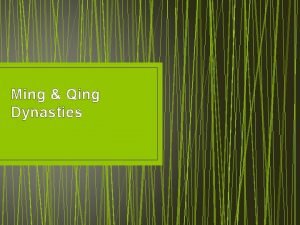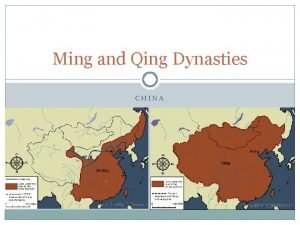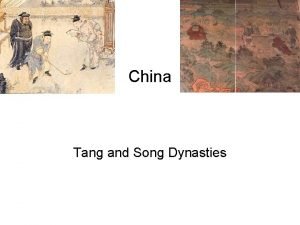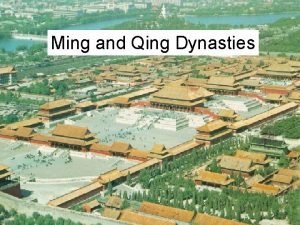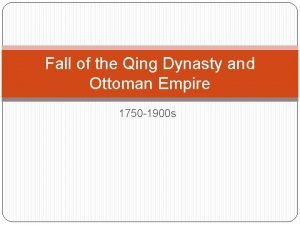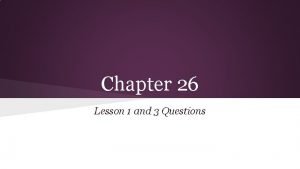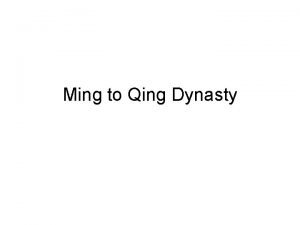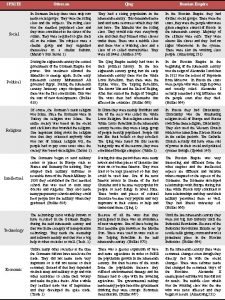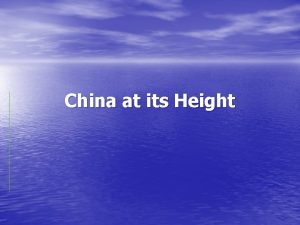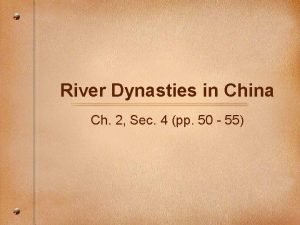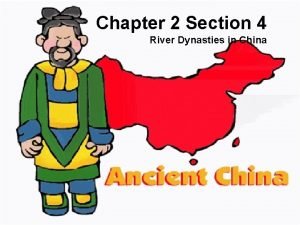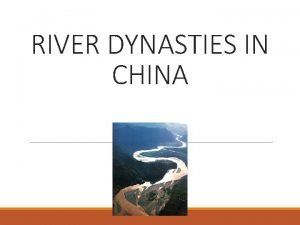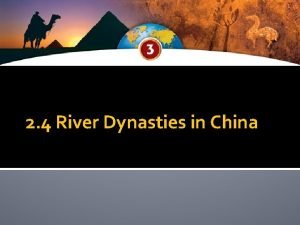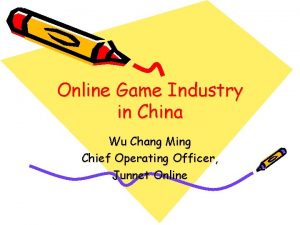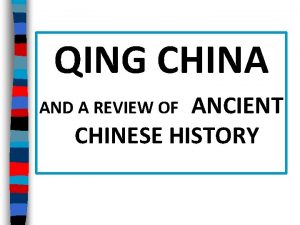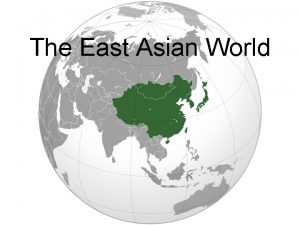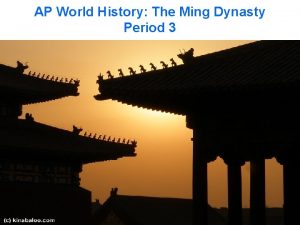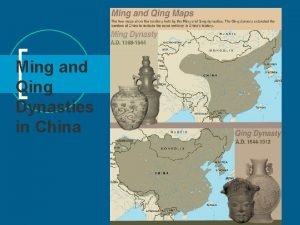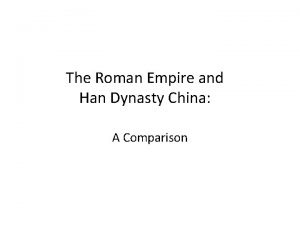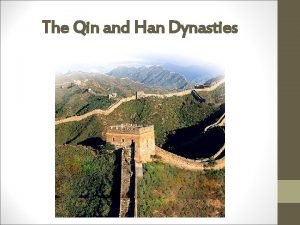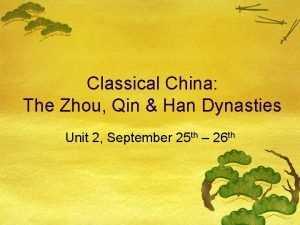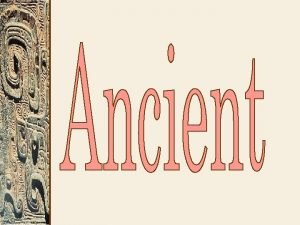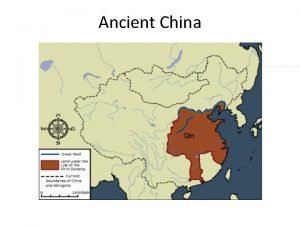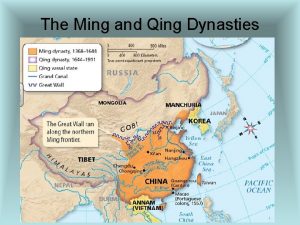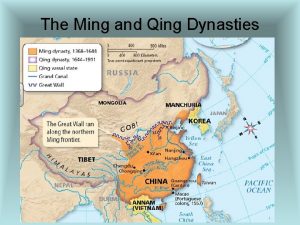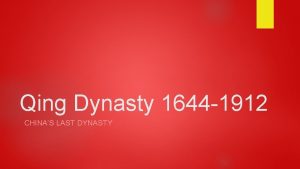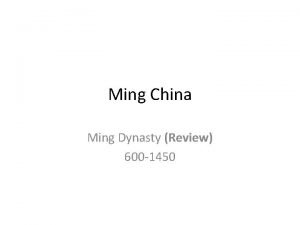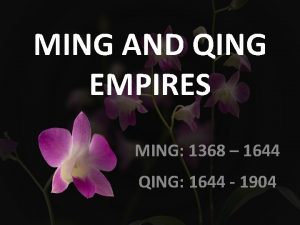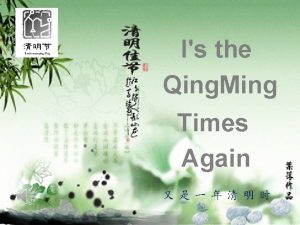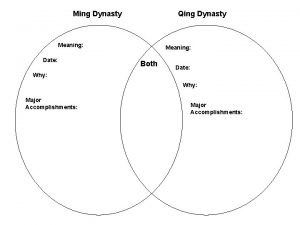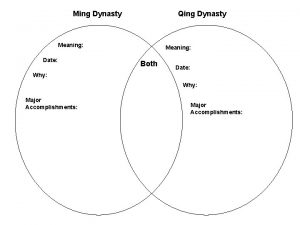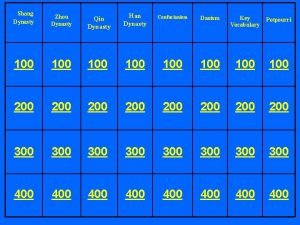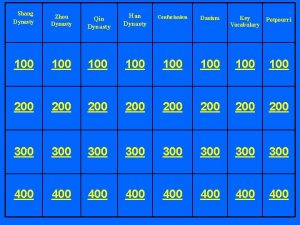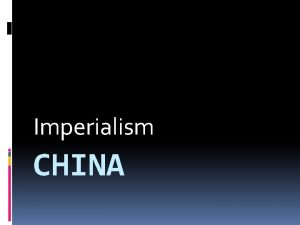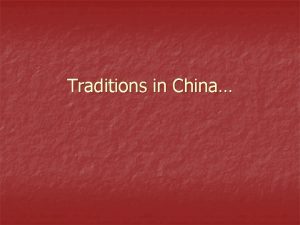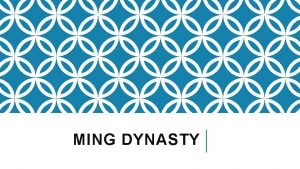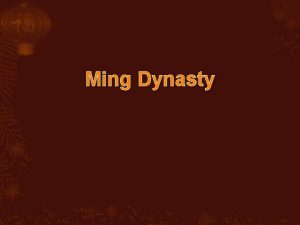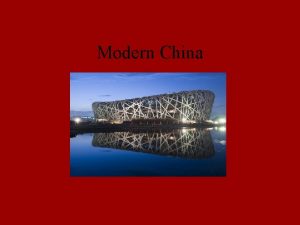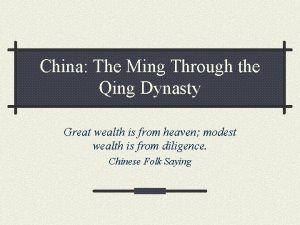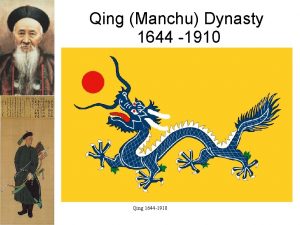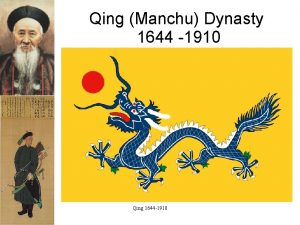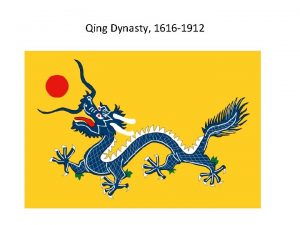Ming and Qing Dynasties CHINA Ming Dynasty Overview
































- Slides: 32

Ming and Qing Dynasties CHINA

Ming Dynasty Overview �Years: 1368 to 1644 �Last native Han emperors in Chinese history �Had to recover from Mongol rule �Culturally, looked to the past Used Han, Tang, and Song models Foreign ideas and influences seen as threatening

Recovery �Hongwu, founder of Ming, begins reforestation project in 1391 1 billion trees replanted in a decade! �Rebuilt canals, reservoirs, irrigation � 15 th century: domestic and foreign trade flourishes, population grows

Emperor Yongle � 1402 to 1422 �Sponsored Zheng He’s voyages �Encyclopedia: 11, 000 volumes; 2, 000 scholars Geography, history, government, ethics �Relocated capital to Beijing in 1421 Forbidden City Temple of Heaven

Forbidden City










Temple of Heaven

Remember Zheng He? �Massive fleet sailed from 1405 to 1433 � 7 expeditions for diplomacy and trade �Ended in 1435 and records destroyed This illustrates how the Ming made the conscious decision to turn inward and adopt a policy of isolationism. Mistake?

Politics �Civil service exam system reestablished �Highly centralized government �Daming Lu Law Code �Dominated by emperor and eunuchs Power struggles between bureaucrats and eunuchs �Rebuilt Great Wall

Great Wall

Economy �Continues shift from rural to urban �Farming still important: rice and tea �Growing trade along coast with Japan and Europe Exports: textiles, silk, porcelain Imports: SILVER, firearms, sugar, potatoes, tobacco �Outside trade highly regulated Foreign enclaves �Rise of markets and merchants


Religion �Neo-Confucianism �Matteo Ricci the first Christian missionary started nearly 300 Catholic churches (Jesuits) �Christian influence condemned in late Ming and early Qing

Fall of Ming corruption of the court officials and the domination of the eunuchs natural disasters like famine from Little Ice Age and worst earthquake of all time in Shaanxi (800, 000 dead) Peasant rebellions Aggressive expansion of the Manchus Manchu rebel Li Zicheng entered Beijing in 1644 Last Ming emperor, Chongzhen, hanged himself on a tree overlooking the Forbidden City

Qing Dynasty Overview � 1644 to 1910 �Last Chinese dynasty �Manchu rule, not ethnic Han Chinese �Early Qing: time of great expansion �Later Qing (after 1750): Big Problems! Internal rebellions European imperialism


Politics �Manchu rule strongly resisted by Han Chinese �Manchus only 2% of population �Continued civil service exam and Neo-Confucianism �BUT Han Chinese forbidden from holding high national office

Expansion �Conquered Mongolia, Central Asia, Taiwan, and Tibet �First dynasty to eliminate threat of land invasion from nomads �Largest land area of any Chinese state �Some regions still resist Chinese control today Tibet Xinjiang (Uighurs)

Economy �Light taxes to win popularity with people �International commerce grew enormously, especially with Japan and Europe �Exported porcelain, silk, spices �Similar to Ming, BUT… Europeans would later use trade power to dominate Qing Dynasty

Religion �Neo-Confucianism �Buddhism, Daoism, and folk religions (ancestor veneration) continue �Christianity grew rapidly Outlawed in 1830 s and 1840 s Catholic and Protestant missionaries

A Catholic Church in Beijing

Society �Han majority discriminated against �Men forced to wear hair in braid humiliating �Women forbidden to bind feet couldn’t enforce, so repealed in 1688 �Manchus did not engage in trade or manual labor �Dual appointments in government: Han to do the work Manchu to ensure his loyalty to Qing

Art �Qing art was imitative, not original �Valued trade over beauty �Porcelain: new colors, including red, green, and black

Exit Pass �Thesis: Analyze changes and continuities in Chinese politics and culture from 1500 to 1750.
 Rise of the qing dynasty
Rise of the qing dynasty Ming dynasty time period
Ming dynasty time period Ming and qing dynasty venn diagram
Ming and qing dynasty venn diagram How did the ming dynasty restore chinese rule to china?
How did the ming dynasty restore chinese rule to china? Qing qing ting
Qing qing ting Qing conquest of the ming
Qing conquest of the ming Qing conquest of the ming
Qing conquest of the ming The fall of the qing dynasty
The fall of the qing dynasty Qing empire decline
Qing empire decline Chapter 26 lesson 1 the decline of the qing dynasty
Chapter 26 lesson 1 the decline of the qing dynasty Qing dynasty dbq
Qing dynasty dbq Qing at its height
Qing at its height Qing dynasty social classes
Qing dynasty social classes How did the sui and tang dynasties reunite china
How did the sui and tang dynasties reunite china Qing china at its height
Qing china at its height Chapter 2 section 4 river dynasties in china
Chapter 2 section 4 river dynasties in china Social classes in song dynasty
Social classes in song dynasty River dynasties in china
River dynasties in china River dynasties in china
River dynasties in china Chartch
Chartch Ming dynasty game online
Ming dynasty game online Bureaucracy
Bureaucracy The wing dynasty menu
The wing dynasty menu Rise of the ming dynasty
Rise of the ming dynasty Ming dynasty ap world history
Ming dynasty ap world history Ming dynasty
Ming dynasty Roman empire china
Roman empire china China qin dynasty map
China qin dynasty map Ancient china roads
Ancient china roads China zhou dynasty
China zhou dynasty How was china reunited under the sui dynasty
How was china reunited under the sui dynasty China zhou dynasty
China zhou dynasty Zhou dynasty wars
Zhou dynasty wars
